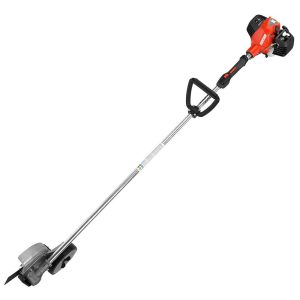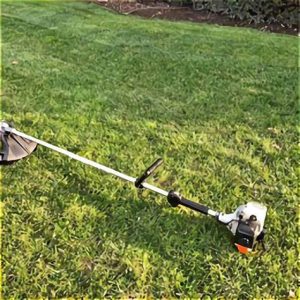How to Service a Ryobi String Trimmer: Step-By-Step
When it comes to a tune-up on your Ryobi string trimmer it’s best to complete a full service annually. The maintenance on your trimmer doesn’t stop there. You will need to inspect your trimmer throughout the lawn care season for oil and fuel leaks; a dirty air filter; and damaged parts.
Service your Ryobi string trimmer by replacing the spark plug, air filter, and fuel filter. Drain old fuel and refill with fresh fuel; check the fuel system; clean the cooling system, and inspect your Ryobi string trimmer for potential problems. Change the engine oil in a 4-cycle Ryobi string trimmer.
Follow all safety instructions found in your operator’s manual before operating or performing any work on your string trimmer. Always wear the proper protection and have all safety guards installed.
Steps to Service a Ryobi String Trimmer:
- Gather tools and supplies
- Remove the spark plug & follow safety precautions
- Replace old fuel
- Change engine oil (4-cycle engine)
- Replace air filter
- Replace fuel filter
- Check the fuel system
- Replace the spark plug
- Clean the cooling system
- Clean the exterior and trimmer head
- Tighten loose hardware & replace broken or missing parts

This post may include affiliate links. Purchases made through these links may provide a commission for us, at no extra cost to you. As an Amazon Associate, we earn from qualifying purchases.
Follow all safety instructions provided in your equipment operator’s manual prior to diagnosing, repairing, or operating.Consult a professional if you don’t have the skills, or knowledge or are not in the condition to perform the repair safely.
Table of Contents
Perform Maintenance on a Ryobi String Trimmer: Step-By-Step
Step 1: Gather Tools and Supplies for Ryobi String Trimmer Maintenance
- Socket set and screwdrivers
- Air filter
- Fuel filter
- Spark plug
- Clean rags
- Engine oil (4-cycle engine model)
- Drain pan or container to collect oil
Step 2: Remove the Spark Plug Wire on Your Ryobi String Trimmer & Follow All Safety Precautions
Remove the spark plug wire. Some people refer to it as the spark plug boot. This is a precaution you must take to prevent your Ryobi string trimmer from starting while you are working on it.
Refer to your operator’s manual for a full list of safety precautions to take while servicing and operating your trimmer.
Step 3: Replace Old Fuel in a Ryobi String Trimmer
Old gas in your string trimmer that has been sitting for longer than 30 days since it was purchased should be drained. Gasoline that has an added fuel stabilizer should be drained if it hasn’t been consumed within 90 days.
Old gas is the culprit for many Ryobi string trimmer failures including clogging the fuel system and damaging the carburetor. Minimize running and starting issues with your Ryobi string trimmer by always using fresh fuel.
2-cycle and 4-cycle Ryobi string trimmers have different fuel requirements. 2-cycle engines require oil to be mixed in the gasoline before filling the fuel tank. 4-cycle engines require straight gasoline.
To help determine whether you have a 2-cycle or 4-cycle engine, look at the number of fill ports on your trimmer. A 2-cycle engine has one fill port and a 4-cycle engine has 2 fill ports. One fill port is for gas and the other is for oil.
Your original fuel cap may also indicate whether you need to use a gas and oil mix if it shows an image of a fuel pump and an oil can. If you’re still unsure of the type of engine on your Ryobi, refer to the operator’s manual.
- Ryobi 2-cycle engine
Use a gas and oil mix in a Ryobi 2-cycle string trimmer that contains a premium 2-cycle oil mixed with unleaded gasoline that has a minimum octane rating of 89 and a maximum ethanol content of 10%.Mix at a ratio of 50:1 which means 50 parts gas is to be mixed with 1 part oil for current Ryobi string trimmer models. Older models may require a 32:1 mix. You can find more information on gas and oil to use in your trimmer in, “This is the Type of Gas and Oil Ryobi String Trimmers Use“.
- Ryobi 4-cycle engine
Use an unleaded gasoline with a minimum octane rating of 89 and a maximum ethanol content of 10%. Oil and gas should never be mixed in a 4-cycle engine.
Add a fuel stabilizer like Sea Foam or STA-BIL to the fuel to stabilize the fuel and reduce moisture in your Ryobi string trimmer.
Step 4: Change Engine Oil on Ryobi 4-Cycle String Trimmer
If your Ryobi string trimmer is using a 4-cycle engine, the engine oil should be changed every 25 hours or annually, whichever comes first.
Warm oil flows better than cold oil when draining the oil tank. If your oil isn’t warm, reattach the spark plug wire and start the trimmer. Allow it to run for a short amount of time and then shut off.
You want the oil to be warm, but not hot. Hot oil and a hot engine can cause injury and scalding. If your engine and oil are too hot, wait for it to cool down so you can safely complete an oil change. Remove the spark plug wire.
Ryobi recommends using a 20W-50 engine oil in their 4-cycle string trimmers. It’s also okay to use SAE30, 10W-30, and 10W-40 engine oil
Change Engine Oil In a Ryobi String Trimmer
Follow these steps to change the engine oil on your Ryobi string trimmer:
- Get a drain pan or other item to collect oil.
- Clean any dirt and debris around the oil fill cap. You do not want dirt to get into the oil tank.
- Remove the oil cap.
- Tilt the trimmer toward the oil fill hole to allow all oil to drain into the drain pan.
- Once emptied, place the string trimmer so the engine sits level. Not having the engine level will cause you to not accurately fill the oil to the correct level required.
- Fill the with the recommended 20W-50 engine oil for your Ryobi string trimmer. Once full, replace the fuel cap/dipstick. Remove the cap/dipstick to check the oil level to make sure it is at the full level on the dipstick. If you are unsure of the fill level for your string trimmer, refer to the operator’s manual. Not enough engine oil or too little engine oil can cause significant engine damage.
- Never use a 2-cycle oil in your 4-cycle engine.
- Replace the oil cap/plug once your oil level is correct.
- Wipe any oil that may have dripped onto the string trimmer.
Step 5: Replace the Air Filter on a Ryobi String Trimmer
You stir up a lot of debris and dust while trimming with your Ryobi. It’s important to use a clean air filter to keep dirt out while allowing clean air to get to the engine. The air filter should be changed annually and regularly cleaned throughout the year.
Replace a Ryobi air filter
- Remove the air filter cover. It may be held on with clips or a latch.
- Remove the dirty air filter.
- Wipe any dirt or debris out of the air filter housing and cover.
- Install a new air filter.
- Reattach the air filter cover.
Clean a Ryobi foam air filter
- Remove the air filter cover. It may be held on with clips or a latch.
- Remove the dirty air filter.
- Wipe any dirt or debris out of the air filter housing.
- Inspect the air filter’s condition. Do not reuse it if it is brittle or damaged. If in good condition, proceed with the steps to clean it.
- Wash the foam filter with warm water and a mild dish soap to remove the dirt.
- Rinse with water until all soap has been removed.
- Lay flat to dry.
- Coat with an air filter oil or clean engine oil. Squeeze to remove excess oil from the filter.
- Install the clean filter.
- Reattach the air filter cover.
Step 6: Replace the Fuel Filter in a Ryobi String Trimmer
The fuel filter strains the fuel before it enters the fuel system to prevent contamination and clogging from dirt and debris. Your Ryobi fuel filter must be changed out regularly to prevent it from becoming plugged and restricting fuel flow.
- Wipe around the fuel cap to remove dirt.
- Remove the fuel cap.
- Pull the filter out of the fuel tank. A clean bent wire may help you pull it out of the tank
- Holding the fuel line and fuel filter, gently pull the filter out of the fuel line. Don’t allow the ring clip to come off of the fuel line.
- Install a new fuel filter into the fuel line with the ring clip over the fuel line and fuel filter male end to secure the fuel line to the filter.
- Place the fuel filter inside the fuel tank.
- Reattach the fuel cap.
Step 7: Check the Fuel System on a Ryobi String Trimmer
Inspect the fuel tank, fuel lines, and fuel cap. If you find leaks or cracks in the tank or fuel lines, they must be replaced before operating the string trimmer. Check the seal in your fuel cap. You don’t want fuel leaking out of the cap area.
Step 8: Replace the Spark Plug on a Ryobi String Trimmer
Remove the spark plug and replace it with a new spark plug that is gapped correctly. Don’t secure the spark plug wire until all work is completed on the string trimmer.
I like to replace my spark plug during the annual service to keep my string trimmer running at its best. If you choose to clean your spark plug, remove the carbon buildup with a wire brush. A spark plug with a very dark tip, broken porcelain, or burnt electrode must be replaced.
Don’t reconnect the spark plug wire until you are finished servicing your Ryobi string trimmer.
Step 9: Clean the Cooling System on a Ryobi String Trimmer
The engine can overheat and shut down when it gets hot due to debris and dirt clogging the air passageways. When the airways become plugged, the air is not able to circulate around the engine to keep it cool.
Confirm the spark plug is removed. Remove the engine cover and remove all debris from the cover and around the engine, including the cooling fins. Remove debris with a bristle brush (not made of metal).
Do not use a metal object to clean the unit as this can damage the string trimmer.
Step 10: Clean the Exterior of a Ryobi String Trimmer
Remove dirt and debris from the exterior of your string trimmer using a clean cloth. Use water with a mild dish soap to dampen the cloth to remove dirt from around the string trimmer head. Avoid cleaners.
Step 11: Tighten Loose Hardware and Replace Missing or Damaged Parts on a Ryobi String Trimmer
Inspect your string trimmer for any hardware that may have become loose. Tighten the hardware. Remove any missing or broken pieces on your string trimmer. Make sure the safety guards and shields are in place. Do not operate your Ryobi string trimmer without them.
Step 12: Reattach Spark Plug Wire on Your Ryobi String Trimmer
Once all services are performed on your Ryobi string trimmer, reattach the spark plug to use the trimmer.







